In cats
Performing a tendonectomy on a cat is an alternative to onychectomy ("declawing"), which amputates the end of each digit. Tendonectomy may be considered less painful for the cat than onychectomy; however, it is not recommended by the American Veterinary Medical Association (AVMA) and is illegal in many countries.
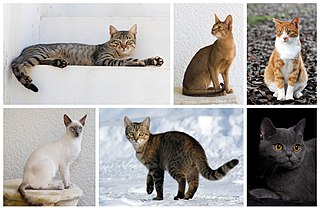
The cat or domestic cat is a small carnivorous mammal. It is the only domesticated species in the family Felidae. The cat is either a house cat, kept as a pet; or a feral cat, freely ranging and avoiding human contact. A house cat is valued by humans for companionship and for its ability to hunt rodents. About 60 cat breeds are recognized by various cat registries.

Onychectomy, popularly known as declawing, is an operation to remove an animal's claws surgically by means of the amputation of all or part of the distal phalanges, or end bones, of the animal's toes. Because the claw develops from germinal tissue within the third phalanx, amputation of the bone is necessary to fully remove the claw. The terms "onychectomy" and "declawing" imply mere claw removal, but a more appropriate description would be phalangectomy, excision of toe bone.

The American Veterinary Medical Association (AVMA), founded in 1863, is a not-for-profit association representing more than 91,000 U.S. veterinarians working in private and corporate practice, government, industry, academia, and uniformed services.
In a tendonectomy, a small portion of the tendon in each of a cat's toes is surgically removed to prevent the cat from extending the claws. Thus, the cat is no longer capable of scratching.
Claws will continue to grow following tendonectomy, and because the cat can no longer extend the claws to scratch, the cat will not wear down the claws as before. Therefore, among other considerations, the cat owner should evaluate the ongoing maintenance required in the form of regular claw trimming thereafter when considering this procedure.
In terms of studies on the impact of onychectomy versus tendonectomy, the American Veterinary Medical Association compared the outcomes of the two operations in its August 1, 1998 issue. Their report considered owner satisfaction and drawbacks such as pain and future complications. Cats who underwent tendonectomy displayed significantly lower pain immediately following the procedure versus those who underwent onychectomy. However, both procedures showed an equal frequency of other complications, such as bleeding, lameness, and infection. Cats took the same number of days to recover from both operations (as measured by normalcy in walking), and owners were equally satisfied with both options.
One complication to watch out for later on in the cat's life with a tendonectomy is the nails getting brittle. Nails that are more brittle are prone to splitting and shattering when trimmed by the owner, which is quite painful for the cat.

Laparoscopy invented by George Kelling in 1901, in Germany, is an operation performed in the abdomen or pelvis using small incisions with the aid of a camera. The laparoscope aids diagnosis or therapeutic interventions with a few small cuts in the abdomen.

Arthroscopy is a minimally invasive surgical procedure on a joint in which an examination and sometimes treatment of damage is performed using an arthroscope, an endoscope that is inserted into the joint through a small incision. Arthroscopic procedures can be performed during ACL reconstruction.

A nail disease or onychosis is a disease or deformity of the nail. Although the nail is a structure produced by the skin and is a skin appendage, nail diseases have a distinct classification as they have their own signs and symptoms which may relate to other medical conditions. Some nail conditions that show signs of infection or inflammation may require medical assistance.
Neutering, from the Latin neuter, is the removal of an animal's reproductive organ, either all of it or a considerably large part. "Neutering" is often used incorrectly to refer only to male animals, but the term actually applies to both sexes. The male-specific term is castration, while spaying is usually reserved for female animals. Colloquially, both terms are often referred to as fixing. In male horses, castrating is referred to as gelding. Modern veterinary practice tends to use the term de-sexing.

Plantar fasciitis is a disorder of the connective tissue which supports the arch of the foot. It results in pain in the heel and bottom of the foot that is usually most severe with the first steps of the day or following a period of rest. Pain is also frequently brought on by bending the foot and toes up towards the shin. The pain typically comes on gradually, and it affects both feet in about one third of cases.
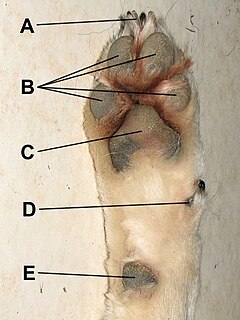
A dewclaw is a digit – vestigial in some animals – on the foot of many mammals, birds, and reptiles. It commonly grows higher on the leg than the rest of the foot, such that in digitigrade or unguligrade species it does not make contact with the ground when the animal is standing. The name refers to the dewclaw's alleged tendency to brush dew away from the grass. On dogs and cats the dewclaws are on the inside of the front legs, positioned analogously to a human thumb. Although many animals have dewclaws, other similar species do not, such as horses, giraffes and the African wild dog.
Devocalization is a surgical procedure performed on dogs and cats, where tissue is removed from the animal's vocal cords to permanently reduce the volume of its vocalizations.

Achilles tendon rupture is when the Achilles tendon, at the back of the ankle, breaks. Symptoms include the sudden onset of sharp pain in the heel. A snapping sound may be heard as the tendon breaks and walking becomes difficult.

A subungual hematoma is a collection of blood (hematoma) underneath a toenail or fingernail. It can be extremely painful for an injury of its size, although otherwise it is not a serious medical condition.

Kneading is an activity common to all domestic cats whereby, when in a state of ease, they alternately push out and pull in their front paws, often alternating between right and left limbs.

Veterinary surgery is surgery performed on animals by veterinarians, whereby the procedures fall into three broad categories: orthopaedics, soft tissue surgery, and neurosurgery. Advanced surgical procedures such as joint replacement, fracture repair, stabilization of cranial cruciate ligament deficiency, oncologic (cancer) surgery, herniated disc treatment, complicated gastrointestinal or urogenital procedures, kidney transplant, skin grafts, complicated wound management, minimally invasive procedures are performed by veterinary surgeons. Most general practice veterinarians perform routine surgery [neuters, minor mass excisions, etc.], some also perform additional procedures.
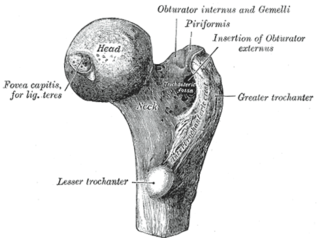
A femoral head ostectomy is a surgical operation to remove the head and neck from the femur. It is performed to alleviate pain, and is a salvage procedure, reserved for condition where pain can not be alleviated in any other way. It is common in veterinary surgery. Other names are excision arthroplasty of the femoral head and neck, Girdlestone's operation, Girdlestone procedure, and femoral head and neck ostectomy.
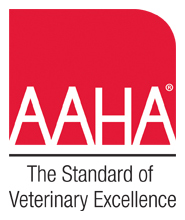
The American Animal Hospital Association (AAHA) is a non-profit organization for companion animal veterinary hospitals. Established in 1933, the association is the only accrediting body for small animal hospitals in the U.S. and Canada. The association develops benchmarks of excellence, business practice standards, publications and educational programs. Any veterinary hospital can join AAHA as a member, but must then pass an evaluation in order to receive AAHA accreditation.
Veterinary anesthesia is anesthesia performed on non-human animals by a veterinarian or a Registered Veterinary Technician. Anesthesia is used for a wider range of circumstances in animals than in people, due to animals' inability to cooperate with certain diagnostic or therapeutic procedures. Veterinary anesthesia includes anesthesia of the major species: dogs, cats, horses, cattle, sheep, goats, and pigs, as well as all other animals requiring veterinary care such as birds, pocket pets, and wildlife.
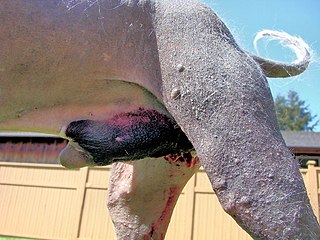
Urethrostomy is a surgical procedure that creates a permanent opening in the urethra, commonly to remove obstructions to urine flow. The procedure is most often performed in male cats, where the opening is made in the perineum.

Clitoral hood reduction, also termed clitoral hoodectomy, clitoral unhooding, clitoridotomy,or (partial) hoodectomy, is a plastic surgery procedure for reducing the size and the area of the clitoral hood (prepuce) in order to further expose the clitoral glans of the clitoris.

Surgical treatments of ingrown toenails include a number of different options. If conservative treatment of a minor ingrown toenail does not succeed or if the ingrown toenail is severe, surgical management by a podiatrist is recommended. The initial surgical approach is typically a partial avulsion of the nail plate known as a wedge resection or a complete removal of the toenail. If the ingrown toenail recurs despite this treatment, destruction of the germinal matrix with phenol is recommended. Antibiotics are not needed if surgery is performed.

Hundreds of millions of cats are kept as pets around the world. Cats have either a mutualistic or commensal relationship with humans.
The Paw Project is a 2013 documentary film that focuses on the declawing of both exotic and domesticated cats in the United States. The film follows the crusade of veterinarian Dr. Jennifer Conrad, who campaigns to have declawing bans enacted in a number of cities. The Paw Project is also the name of the nonprofit organization founded by Conrad over the course of the film.


















